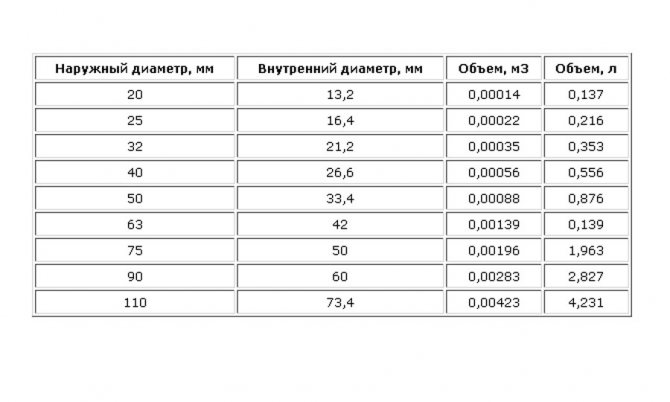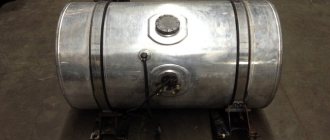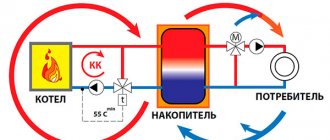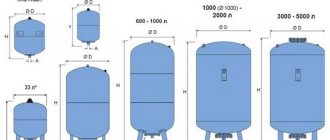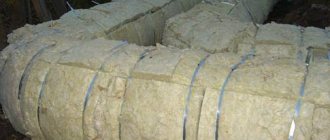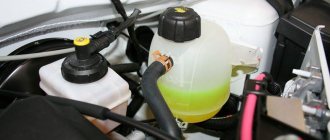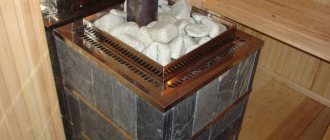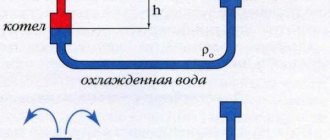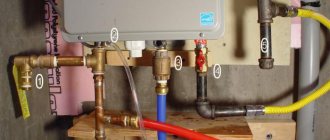Calculation of heating a private house
Arrangement of housing with a heating system is the main component of creating comfortable temperature conditions in the house for living in it.
There are many elements in the piping of the thermal circuit, so it is important to pay attention to each of them. It is equally important to correctly calculate the heating of a private house, on which the efficiency of the heating unit, as well as its efficiency, largely depends. And how to calculate the heating system according to all the rules, you will learn from this article
And how to calculate the heating system according to all the rules, you will learn from this article.

- What is the heating unit made of?
- Heating element selection
- Determination of boiler output
- Calculation of the number and volume of heat exchangers
- What determines the number of radiators
- Formula and calculation example
- Pipeline heating system
- Installation of heating devices
Calculation of the power of the heating system by the area of housing
One of the fastest and easiest to understand ways to determine the power of the heating system is to calculate the area of the room. This method is widely used by sellers of heating boilers and radiators. The calculation of the power of the heating system by area takes place in a few simple steps.
You may be interested in information-heat meters for heating
Step 1. According to the plan or an already erected building, the internal area of the building is determined in square meters.
Step 2. The resulting figure is multiplied by 100-150 - that is how many watts of the total power of the heating system are needed for each m2 of housing.
Step 3. Then the result is multiplied by 1.2 or 1.25 - this is necessary to create a reserve of power so that the heating system is able to maintain a comfortable temperature in the house even in the event of the most severe frosts.
Step 4. The final figure is calculated and recorded - the power of the heating system in watts, required to heat a particular home. As an example, to maintain a comfortable temperature in a private house with an area of 120 m2, approximately 15,000 watts are required.
Advice! In some cases, the owners of cottages divide the internal area of the housing into the part that requires serious heating, and the part for which this is unnecessary. Accordingly, different coefficients are applied for them - for example, for living rooms it is 100, and for technical rooms - 50-75.
Step 5. According to the already determined calculated data, a specific model of the heating boiler and radiators is selected.
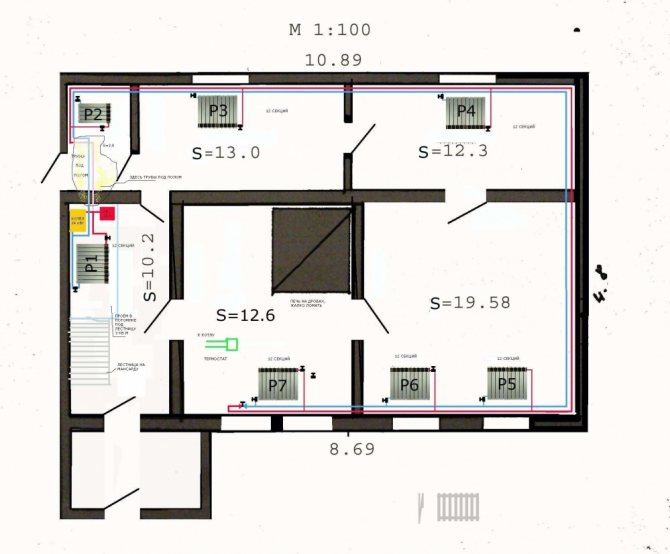

Calculation of the area of the cottage according to its plan. Also, the mains of the heating system and the places of installation of radiators are marked here.
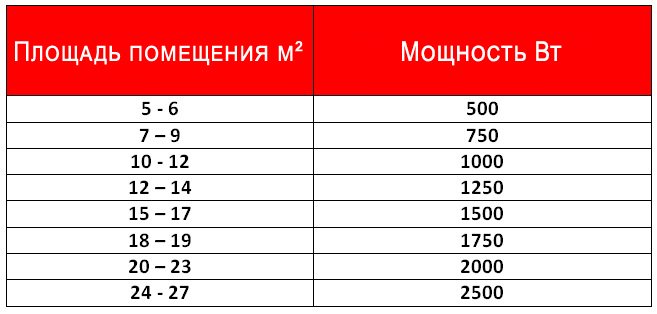

Table for calculating the power of radiators by the area of the room
It should be understood that the only advantage of this method of thermal calculation of the heating system is speed and simplicity. Moreover, the method has many disadvantages.
- The lack of accounting for the climate in the area where the housing is being built - for Krasnodar, a heating system with a capacity of 100 W per square meter will be clearly excessive. And for the Far North, it may not be enough.
- The lack of taking into account the height of the premises, the type of walls and floors from which they are erected - all these characteristics seriously affect the level of possible heat losses and, consequently, the required power of the heating system for the house.
- The very method of calculating the heating system by power was originally developed for large industrial premises and apartment buildings. Therefore, it is not correct for an individual cottage.
- Lack of accounting for the number of windows and doors facing the street, while each of these objects is a kind of "cold bridge".
So does it make sense to apply the calculation of the heating system by area? Yes, but only as a preliminary estimate, allowing you to get at least some idea of the issue. To achieve better and more accurate results, you should turn to more complex methods.
Heating devices
How to calculate heating in a private house for individual rooms and select heating devices corresponding to this power?
The very method of calculating the heat demand for a separate room is completely identical to the one given above.
For example, for a room with an area of 12 m2 with two windows in the house we have described, the calculation will look like this:
- The volume of the room is 12 * 3.5 = 42 m3.
- The basic thermal power will be 42 * 60 = 2520 watts.
- Two windows will add another 200 to it.2520 + 200 = 2720.
- The regional coefficient will double the heat demand. 2720 * 2 = 5440 watts.
How to convert the resulting value into the number of radiator sections? How to choose the number and type of heating convectors?
Manufacturers always indicate the heat output for convectors, plate radiators, etc. in the accompanying documentation.


Power table for VarmannMiniKon convectors.
- For sectional radiators, the necessary information can usually be found on the websites of dealers and manufacturers. There you can often find a calculator for converting kilowatts in the section.
- Finally, if you use sectional radiators of unknown origin, with their standard size of 500 millimeters along the axes of the nipples, you can focus on the following averaged values:
Thermal power per section, watts
In an autonomous heating system with its moderate and predictable parameters of the coolant, aluminum radiators are most often used. Their reasonable price is very pleasantly combined with a decent appearance and high heat dissipation.
In our case, aluminum sections with a capacity of 200 watts will require 5440/200 = 27 (rounded off).
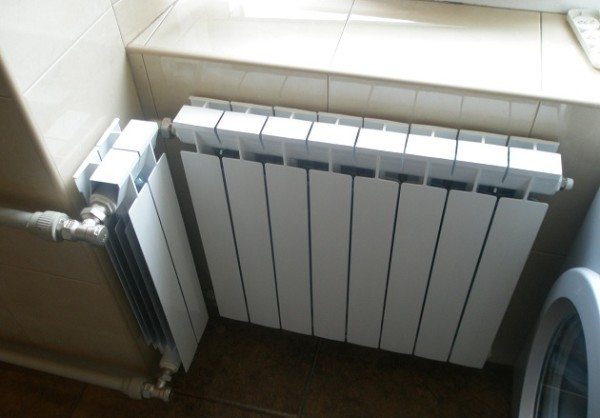

Placing so many sections in one room is not a trivial task.
As always, there are a couple of subtleties.
- With a lateral connection of a multi-section radiator, the temperature of the last sections is much lower than the first; accordingly, the heat flux from the heater falls. A simple instruction will help to solve the problem: connect radiators according to the “bottom-down” scheme.
- Manufacturers indicate the heat output for the delta of temperatures between the coolant and the room at 70 degrees (for example, 90 / 20C). When it decreases, the heat flux will fall.
A special case
Often, homemade steel registers are used as heating devices in private houses.
Please note: they attract not only by their low cost, but also by their exceptional tensile strength, which is very useful when connecting a house to a heating main. In an autonomous heating system, their attractiveness is nullified by their unassuming appearance and low heat transfer per unit volume of the heater
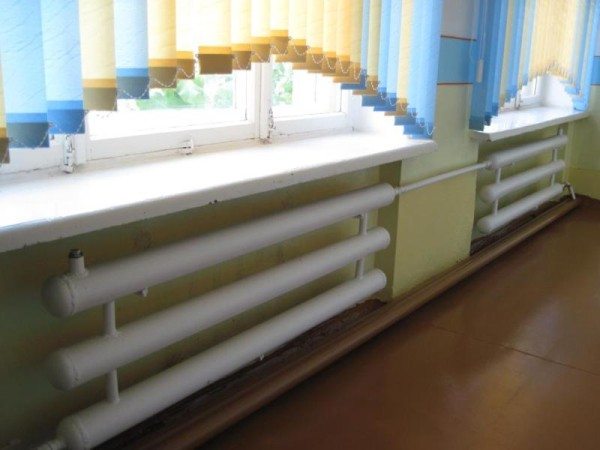

Let's face it - not the height of aesthetics.
Nevertheless: how to estimate the thermal power of a register of a known size?
For a single horizontal round pipe, it is calculated by the formula of the form Q = Pi * Dн * L * k * Dt, in which:
- Q is the heat flow;
- Pi - number "pi", taken equal to 3.1415;
- Dн - outer diameter of the pipe in meters;
- L is its length (also in meters);
- k - coefficient of thermal conductivity, which is taken equal to 11.63 W / m2 * C;
- Dt is the delta temperature, the difference between the coolant and the air in the room.
In a multisection horizontal register, the heat transfer of all sections, except for the first one, is multiplied by 0.9, since they give off heat to the upward flow of air heated by the first section.


In a multi-section register, the lower section gives off the most heat.
Let's calculate the heat transfer of a four-section register with a section diameter of 159 mm and a length of 2.5 meters at a coolant temperature of 80 C and an air temperature in the room of 18 C.
- The heat transfer of the first section is 3.1415 * 0.159 * 2.5 * 11.63 * (80-18) = 900 watts.
- The heat transfer of each of the other three sections is 900 * 0.9 = 810 watts.
- The total thermal power of the heater is 900+ (810 * 3) = 3330 watts.
Calculation of the volume of the expansion tank for heating


Expansion tank design
For the safe operation of the heating system, it is necessary to install special equipment - an air vent, a drain valve and an expansion tank. The latter is designed to compensate for the thermal expansion of hot water and reduce the critical pressure to normal values.
Closed tank
The actual volume of the expansion vessel for the heating system is not constant. This is due to its design. For closed heat supply circuits, membrane models are installed, divided into two chambers. One of them is filled with air with a certain pressure indicator. It should be less than critical for the heating system by 10% -15%. The second part is filled with water from a branch pipe connected to the mains.
To calculate the volume of the expansion tank in the heating system, you need to find out its filling factor (Kzap). This value can be taken from the table data:


Expansion vessel filling factor table
In addition to this indicator, it will be necessary to determine additional:
- The normalized coefficient of thermal expansion of water at a temperature of + 85 ° C, E - 0.034;
- The total volume of water in the heating system, C;
- Initial (Rmin) and maximum (Rmax) pressure in pipes.
Further calculations of the volume of the expansion tank for the heating system are performed according to the formula:
If antifreeze or other non-freezing liquid is used in the heat supply, the value of the expansion coefficient will be 10-15% higher. According to this method, the capacity of the expansion tank in the heating system can be calculated with great accuracy.
The expansion tank volume cannot be included in the total heat supply. These are dependent values that are calculated in a strict sequence - first the heating, and only then the expansion tank.
Open expansion tank
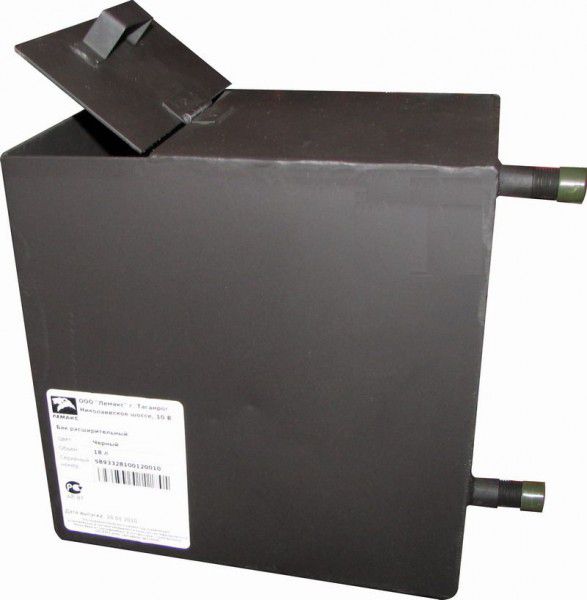

Open expansion tank
To calculate the volume of an open expansion tank in a heating system, you can use a less time-consuming technique. Less requirements are imposed on it, since in fact it is necessary to control the level of the coolant.
The main factor is the thermal expansion of water as its heating rate increases. This indicator is 0.3% for every + 10 ° С. Knowing the total volume of the heating system and the thermal mode of operation, you can calculate the maximum volume of the tank. It should be remembered that it can only be 2/3 filled with coolant. Suppose that the capacity of pipes and radiators is 450 liters, and the maximum temperature is + 90 ° C. Then the recommended volume of the expansion tank is calculated using the following formula:
Vtank = 450 * (0.003 * 9) / 2/3 = 18 liters.
It is recommended to increase the obtained result by 10-15%. This is due to possible changes in the total calculation of the volume of water in the heating system when installing additional batteries and radiators.
If an open expansion tank performs the functions of monitoring the coolant level, its maximum filling level is determined by the installed additional side branch pipe.
Choice of coolant
Most often, water is used as a working fluid for heating systems. However, antifreeze can be an effective alternative solution. Such a liquid does not freeze when the ambient temperature drops to a critical mark for water. Despite the obvious advantages, the price of antifreeze is quite high. Therefore, it is used mainly for heating buildings of insignificant area.


Filling heating systems with water requires preliminary preparation of such a coolant. The liquid must be filtered to remove dissolved mineral salts.For this, specialized chemicals that are commercially available can be used. Moreover, all air must be removed from the water in the heating system. Otherwise, the efficiency of space heating may decrease.
Good to know about the capacity of the heating system
When the owner of a house or apartment has completed the calculations and now knows the volume of the heating system of his home, he needs to ensure the correct injection of liquid into the closed heating structure.
Today, there are two options for solving this problem:
- Using the pump
... You can use the pumping equipment used when watering the backyard. In this case, it is necessary to pay attention to the indicators of the manometer (see the photo of this device) and open the air outlet elements of the heat supply system. - Gravity
... In the second case, the heating system is filled from the highest point of the structure. Having opened the drain valve, you can see the moment when the coolant begins to flow out of it.
Calculation of the volume of the heating system in the video:
Calculating the volume of water in the heating system with an online calculator
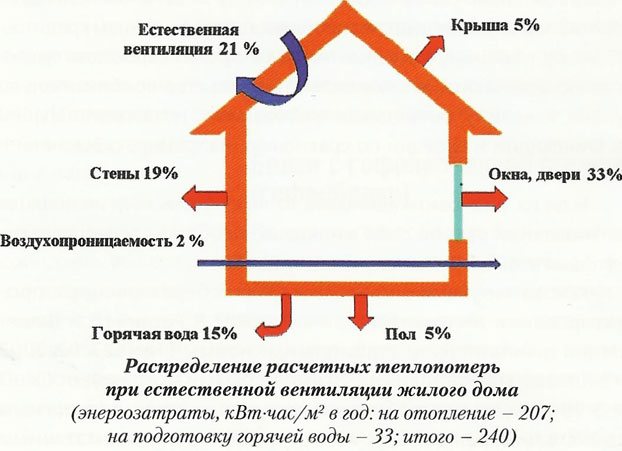

Each heating system has a number of significant characteristics - nominal thermal power, fuel consumption and the volume of the coolant. Calculation of the volume of water in the heating system requires an integrated and scrupulous approach. So, you can find out which boiler, what power to choose, determine the volume of the expansion tank and the required amount of liquid to fill the system.
A significant part of the liquid is located in pipelines, which occupy the largest part in the heat supply scheme.
Therefore, to calculate the volume of water, you need to know the characteristics of the pipes, and the most important of them is the diameter, which determines the capacity of the liquid in the line.
If the calculations are made incorrectly, then the system will not work efficiently, the room will not warm up at the proper level. An online calculator will help to make the correct calculation of volumes for the heating system.
Heating system liquid volume calculator
Pipes of various diameters can be used in the heating system, especially in collector circuits. Therefore, the volume of liquid is calculated using the following formula:
The volume of water in the heating system can also be calculated as the sum of its components:
Taken together, these data allow you to calculate most of the volume of the heating system. However, in addition to pipes, there are other components in the heating system. To calculate the volume of the heating system, including all important components of the heating supply, use our online calculator for the volume of the heating system.
Advice
Calculating with a calculator is very easy. It is necessary to enter in the table some parameters regarding the type of radiators, the diameter and length of the pipes, the volume of water in the collector, etc. Then you need to click on the "Calculate" button and the program will give you the exact volume of your heating system.
You can check the calculator using the above formulas.
An example of calculating the volume of water in the heating system:
The values of the volumes of various components
Radiator water volume:
- aluminum radiator - 1 section - 0.450 liters
- bimetallic radiator - 1 section - 0.250 liters
- new cast iron battery 1 section - 1,000 liters
- old cast iron battery 1 section - 1,700 liters.
The volume of water in 1 running meter of the pipe:
- ø15 (G ½ ") - 0.177 liters
- ø20 (G ¾ ") - 0.310 liters
- ø25 (G 1.0 ″) - 0.490 liters
- ø32 (G 1¼ ") - 0.800 liters
- ø15 (G 1½ ") - 1.250 liters
- ø15 (G 2.0 ″) - 1.960 liters.
To calculate the entire volume of liquid in the heating system, you also need to add the volume of the coolant in the boiler. These data are indicated in the accompanying passport of the device, or take approximate parameters:
- floor boiler - 40 liters of water;
- wall-mounted boiler - 3 liters of water.
The choice of a boiler directly depends on the volume of liquid in the heat supply system of the room.
The main types of coolants
There are four main types of fluid used to fill heating systems:
- Water is the simplest and most affordable heat carrier that can be used in any heating systems. Together with polypropylene pipes, which prevent evaporation, water becomes an almost eternal heat carrier.
- Antifreeze - this coolant will cost more than water, and is used in systems of irregularly heated rooms.
- Alcohol-based heat transfer fluids are an expensive option for filling a heating system. A high-quality alcohol-containing liquid contains from 60% alcohol, about 30% water and about 10% of the volume are other additives. Such mixtures have excellent antifreeze properties, but are flammable.
- Oil - is used as a heat carrier only in special boilers, but it is practically not used in heating systems, since the operation of such a system is very expensive. Also, the oil heats up for a very long time (warming up to at least 120 ° C is required), which is technologically very dangerous, while such a liquid cools down for a very long time, maintaining a high temperature in the room.
In conclusion, it should be said that if the heating system is being modernized, pipes or batteries are installed, then it is necessary to recalculate its total volume, according to the new characteristics of all elements of the system.
The procedure for calculating the volume of the heating system
If your heating system consists of pipes with a diameter of 80-100 mm, as is often the case in an open-type heating system, then you should go to the next item - pipe calculation. If your heating system uses standard radiators, then it is better to start with them.
Calculation of the volume of the coolant in heating radiators
In addition to the fact that heating radiators are of different types, they also have different heights. For determining the volume of the coolant in heating radiators it is convenient to first count the number of sections of the same size and type and multiply them by the internal volume of one section.
Table 1. Internal volume of 1 heating radiator section in liters, depending on the size and material of the radiator.
| Heating radiator material | Center-to-center distance for connecting heating radiators, mm | ||
| 300 | 350 | 500 | |
| Volume, l | |||
| Aluminum | — | 0,36 | 0,44 |
| Bimetal | — | 0,16 | 0,2 |
| Cast iron | 1,11 | — | 1,45 |
To simplify calculations, data on the volume of one section are summarized in a table depending on the type and height of the heating radiator.
Example.
There are 5 aluminum radiators in 7 sections, the center-to-center connection distance is 500mm. It is necessary to find the volume.
We count. 5x7x0.44 = 15.4 liters.
Calculation of the volume of the coolant in the heating pipes
For calculating the volume of the coolant in the heating pipes it is necessary to determine the total length of all pipes of the same type and multiply it by the internal volume of 1 lm. pipes of the appropriate diameter.
It should be noted that the internal volume of pipes made of polypropylene, metal-plastic and steel differ... Table 2 shows the characteristics of steel heating pipes.
Table 2. Internal volume of 1 meter of steel pipe.
| Diameter, inches | Outside diameter, mm | Inner diameter, mm | volume, m3 | Volume, l |
| 1/2» | 21,3 | 15 | 0,00018 | 0,177 |
| 3/4» | 26,8 | 20 | 0,00031 | 0,314 |
| 1» | 33,5 | 25 | 0,00049 | 0,491 |
| 1 1/4» | 42,3 | 32 | 0,00080 | 0,804 |
| 1 1/2» | 48 | 40 | 0,00126 | 1,257 |
| 2» | 60 | 50 | 0,00196 | 1,963 |
| 2 1/2» | 75,5 | 70 | 0,00385 | 3,848 |
| 3» | 88,5 | 80 | 0,00503 | 5,027 |
| 3 1/2» | 101,3 | 90 | 0,00636 | 6,362 |
| 4» | 114 | 100 | 0,00785 | 7,854 |
Table 3 shows the characteristics of reinforced polypropylene pipes, most often used for heating PN20.
Table 3. Internal volume of 1 meter of polypropylene pipe.
| Outside diameter, mm | Inner diameter, mm | volume, m3 | Volume, l |
| 20 | 13,2 | 0,00014 | 0,137 |
| 25 | 16,4 | 0,00022 | 0,216 |
| 32 | 21,2 | 0,00035 | 0,353 |
| 40 | 26,6 | 0,00056 | 0,556 |
| 50 | 33,4 | 0,00088 | 0,876 |
| 63 | 42 | 0,00139 | 0,139 |
| 75 | 50 | 0,00196 | 1,963 |
| 90 | 60 | 0,00283 | 2,827 |
| 110 | 73,4 | 0,00423 | 4,231 |
Table 4 shows the characteristics of reinforced-plastic pipes.
Table 4. Internal volume of 1 meter of metal-plastic pipe.
| Outside diameter, mm | Inner diameter, mm | volume, m3 | Volume, l |
| 16 | 12 | 0,00011 | 0,113 |
| 20 | 16 | 0,00020 | 0,201 |
| 26 | 20 | 0,00031 | 0,314 |
| 32 | 26 | 0,00053 | 0,531 |
| 40 | 33 | 0,00086 | 0,855 |
Antifreeze parameters and types of coolants
The basis for the production of antifreeze is ethylene glycol or propylene glycol.In their pure form, these substances are very aggressive media, but additional additives make antifreeze suitable for use in heating systems. The degree of anti-corrosion resistance, service life and, accordingly, the final cost depend on the additives introduced.
The main task of the additives is to protect against corrosion. Having a low thermal conductivity, the rust layer becomes a heat insulator. Its particles contribute to the clogging of the channels, disable the circulation pumps, and lead to leaks and damage in the heating system.
Moreover, the narrowing of the inner diameter of the pipeline entails hydrodynamic resistance, due to which the speed of the coolant decreases, and energy consumption increases.
Antifreeze has a wide temperature range (from -70 ° C to + 110 ° C), but by changing the proportions of water and concentrate, you can get a liquid with a different freezing point. This allows you to use intermittent heating and only turn on space heating when needed. As a rule, antifreeze is offered in two types: with a freezing point of no more than -30 ° C and no more than -65 ° C.
In industrial refrigeration and air conditioning systems, as well as in technical systems with no special environmental requirements, antifreeze based on ethylene glycol with anti-corrosion additives is used. This is due to the toxicity of the solutions. For their use, expansion tanks of a closed type are required; use in double-circuit boilers is not allowed.
A solution based on propylene glycol obtained other possibilities of application. It is an environmentally friendly and safe composition that is used in food, perfumery and residential buildings. Wherever it is required to prevent the possibility of toxic substances entering the soil and groundwater.
The next type is triethylene glycol, which is used at high temperature conditions (up to 180 ° C), but its parameters are not widely used.
How to calculate the expansion coefficient
When calculating the volume of the heating system, you should pay attention to the expansion coefficient of the liquid used as a heat carrier. This parameter can be characterized by two values, depending on the type of installed heating equipment.
In the case when water is used as a heat carrier in the heating system, then the expansion coefficient is 4%, and if ethylene glycol is 4.4%.
There are other, less accurate ways to calculate the volume of the heating system. For example, you can use the power indicator of a heating unit: it is assumed that 1 kW corresponds to 15 liters of coolant. Thus, in order to find out the approximate capacity of all elements of the heating structure, it is necessary to know the capacity of the heat supply system.
It is often not required to know the exact volume of a heating radiator, boiler, or pipeline. A specific case will be considered as an example. The total power of the entire heating structure is 60 kW, then its total volume is calculated as follows: VS = 60x15 = 900 liters.


It must be borne in mind that the installation of modern elements of the heat supply system, such as batteries, pipes, a boiler, to some extent contribute to a decrease in its total volume. Detailed information on the capacity of the heating radiator or other components of the heating structure is contained in the technical documentation supplied by the manufacturers to their products.
Coolant requirements
You need to immediately understand that there is no ideal coolant. Those types of coolants that exist today can perform their functions only in a certain temperature range. If you go beyond this range, then the characteristics of the quality of the coolant can change dramatically.
The heat carrier for heating must have such properties that will allow for a certain unit of time to transfer as much heat as possible. The viscosity of the coolant largely determines what effect it will have on the pumping of the coolant throughout the heating system for a specific time interval. The higher the viscosity of the coolant, the better characteristics it has.
Physical properties of coolants
The coolant should not have a corrosive effect on the material from which pipes or heating devices are made.
If this condition is not met, then the choice of materials will become more limited. In addition to the above properties, the coolant must also have lubricating properties. The choice of materials that are used for the construction of various mechanisms and circulation pumps depends on these characteristics.
In addition, the coolant must be safe based on such characteristics as: ignition temperature, release of toxic substances, flash of vapors. Also, the coolant should not be too expensive, studying the reviews, you can understand that even if the system works efficiently, it will not justify itself from a financial point of view.
A video about how the system is filled with coolant and how the coolant is replaced in the heating system can be viewed below.
Calculation of water consumption for heating Heating system
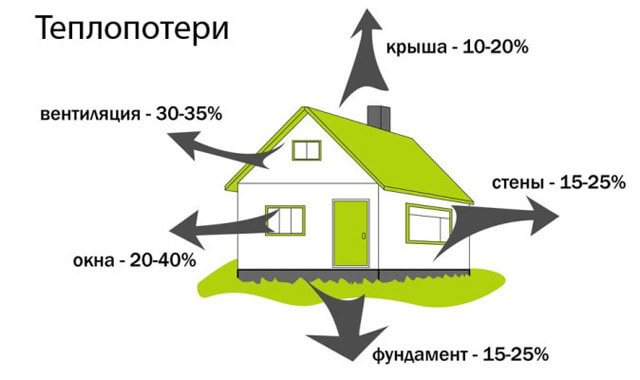

»Heating calculations
The heating design includes a boiler, a connection system, air supply thermostats, manifolds, fasteners, an expansion tank, batteries, pressure-increasing pumps, pipes.
Any factor is definitely important. Therefore, the choice of installation parts must be done correctly. On the open tab, we will try to help you choose the necessary installation parts for your apartment.
The heating installation of the mansion includes important devices.
Page 1
The estimated flow rate of network water, kg / h, to determine the diameters of pipes in water heating networks with high-quality regulation of heat supply should be determined separately for heating, ventilation and hot water supply according to the formulas:
for heating
(40)
maximum
(41)
in closed heating systems
average hourly, with a parallel circuit for connecting water heaters
(42)
maximum, with a parallel circuit for connecting water heaters
(43)
average hourly, with two-stage connection schemes for water heaters
(44)
maximum, with two-stage connection schemes for water heaters
(45)
Important
In formulas (38 - 45), the calculated heat fluxes are given in W, the heat capacity c is taken equal. These formulas are calculated in stages for temperatures.
The total estimated consumption of network water, kg / h, in two-pipe heating networks in open and closed heat supply systems with high-quality regulation of heat supply should be determined by the formula:
(46)
Coefficient k3, taking into account the share of the average hourly water consumption for hot water supply when regulating the heating load, should be taken according to table No. 2.
Table 2. Coefficient values
r-Radius of a circle equal to half the diameter, m
Q-flow rate of water m 3 / s
D-Internal pipe diameter, m
V-speed of the coolant flow, m / s
Resistance to the movement of the coolant.
Any coolant moving inside the pipe strives to stop its movement. The force that is applied to stop the movement of the coolant is the resistance force.
This resistance is called pressure loss. That is, the moving heat carrier through a pipe of a certain length loses pressure.
The head is measured in meters or in pressures (Pa). For convenience, it is necessary to use meters in the calculations.
Sorry, but I'm used to specifying head loss in meters. 10 meters of water column create 0.1 MPa.
In order to better understand the meaning of this material, I recommend following the solution of the problem.
Objective 1.
In a pipe with an inner diameter of 12 mm, water flows at a speed of 1 m / s. Find the expense.
Decision:
You must use the above formulas:
Advantages and disadvantages of water
The undoubted advantage of water is the highest heat capacity among other liquids. It requires a significant amount of energy to heat it, but at the same time it allows you to transfer a considerable amount of heat during cooling. As the calculation shows, when 1 liter of water is heated to a temperature of 95 ° C and it is cooled to 70 ° C, 25 kcal of heat will be released (1 calorie is the amount of heat required to heat 1 g of water per 1 ° C).
Water leakage during depressurization of the heating system will not have a negative impact on health and well-being. And in order to restore the initial volume of the coolant in the system, it is enough to add the missing amount of water to the expansion tank.
The disadvantages include freezing of water. After starting the system, constant monitoring of its smooth operation is required. If it becomes necessary to leave for a long time or for some reason the supply of electricity or gas is interrupted, then you will have to drain the coolant from the heating system. Otherwise, at low temperatures, freezing, the water will expand and the system will rupture.
The next drawback is the ability to cause corrosion in the internal components of the heating system. Water that is not properly prepared can contain increased levels of salts and minerals. When heated, this contributes to the appearance of precipitation and the build-up of scale on the walls of the elements. All this leads to a decrease in the internal volume of the system and a decrease in heat transfer.
To avoid this drawback or to minimize it, they resort to water purification and softening by introducing special additives into its composition, or other methods are used.
Boiling is the simplest and most familiar way to everyone. During processing, a significant part of the impurities will be deposited in the form of scale at the bottom of the container.
Using a chemical method, a certain amount of slaked lime or soda ash is added to the water, which will lead to the formation of a sludge. After the end of the chemical reaction, the precipitate is removed by filtration of water.
There are fewer impurities in rain or melt water, but for heating systems, the best option would be distilled water, in which these impurities are completely absent.
If there is no desire to deal with the shortcomings, then you should think about an alternative solution.
Expansion tank
And in this case, there are two calculation methods - simple and accurate.
Simple circuit
A simple calculation is utterly simple: the volume of the expansion tank is taken equal to 1/10 of the volume of the coolant in the circuit.
Where to get the value of the volume of the coolant?
Here are a couple of the simplest solutions:
- Fill the circuit with water, bleed air, and then drain all the water through a vent into any measuring container.
- In addition, the rough volume of a balanced system can be calculated at the rate of 15 liters of coolant per kilowatt of boiler power. So, in the case of a 45 kW boiler, the system will have approximately 45 * 15 = 675 liters of coolant.
Therefore, in this case, a reasonable minimum would be an expansion tank for the heating system of 80 liters (rounded up to the standard value).
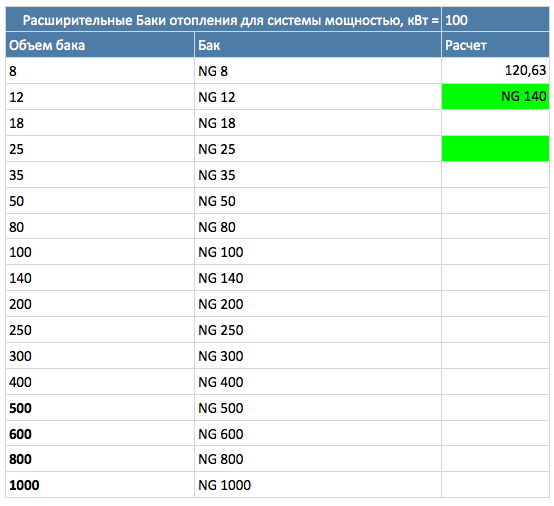

Standard volumes of expansion tanks.
Exact scheme
More precisely, you can calculate the volume of the expansion tank with your own hands using the formula V = (Vt x E) / D, in which:
- V is the desired value in liters.
- Vt is the total volume of the coolant.
- E is the coefficient of expansion of the coolant.
- D is the efficiency factor of the expansion tank.
The expansion coefficient of water and poor water-glycol mixtures can be taken from the following table (when heated from an initial temperature of +10 C):


And here are the coefficients for coolants with a high glycol content.
The tank efficiency factor can be calculated using the formula D = (Pv - Ps) / (Pv + 1), in which:
Pv - maximum pressure in the circuit (pressure relief valve).
Hint: usually it is taken equal to 2.5 kgf / cm2.
Ps - static pressure of the circuit (it is also the pressure of the tank charging). It is calculated as 1/10 of the difference in meters between the level of the tank location and the top point of the circuit (an excess pressure of 1 kgf / cm2 raises the water column by 10 meters). A pressure equal to Ps is generated in the tank air chamber before filling the system.
Let's calculate the tank requirements for the following conditions as an example:
- The difference in height between the tank and the top point of the contour is 5 meters.
- The power of the heating boiler in the house is 36 kW.
- The maximum water heating is 80 degrees (from 10 to 90C).
- The efficiency factor of the tank will be (2.5-0.5) / (2.5 + 1) = 0.57.
Instead of calculating the coefficient, you can take it from the table.
- The volume of the coolant at the rate of 15 liters per kilowatt is 15 * 36 = 540 liters.
- The expansion coefficient of water when heated to 80 degrees is 3.58%, or 0.0358.
- Thus, the minimum tank volume is (540 * 0.0358) / 0.57 = 34 liters.
Calculator for calculating the total volume of the heating system
Sometimes the owners of houses or apartments in which autonomous water heating is installed, there is a need to accurately determine the total volume of the system. Most often this is due to the need to carry out certain preventive and routine maintenance, during which it is necessary to completely empty the system, and then fill it with a new coolant. When using ordinary water, this may not be so relevant (although it is desirable to properly prepare it for such a "mission"), but when a special coolant is purchased, which can be expensive, you cannot do without knowing the volume to plan a purchase.
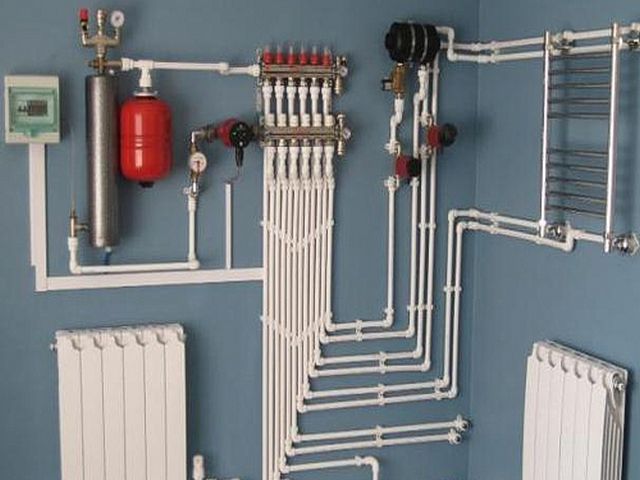

Calculator for calculating the total volume of the heating system
Information about the volume of the heating system is sometimes needed for other needs. So, for example, this value is required without fail for the correct selection of the expansion tank. Some calculations carried out during the modernization of the system and the replacement of one or another equipment may also require this value to be substituted into the heat engineering formulas. In a word, knowing such a parameter will never be superfluous. And the calculator for calculating the total volume of the heating system located below will help to determine with it.
Expansion tank prices
expansion tank
In the course of the calculation, ambiguities may arise - for this case, the necessary explanations are placed below the calculator.
Calculator for calculating the total volume of the heating system
Go to calculations
Explanations on making calculations
So, if there is no way to measure the volume of the heating system experimentally (for example, by carefully filling it from the water supply, with a notch of the readings of the water flow meter), then you will have to carry out mathematical calculations. They boil down to the fact that the summation of the volumes of all devices and pipe circuits installed in the system is carried out. Some of the values should already be known, the rest can be calculated using the geometric formulas of the volume.
- The volume of the boiler heat exchanger - this value is always found in the technical documentation of any model.
- Expansion tank volume. He, too, must be known to the owners. The fact that any tank should never be filled to the top is taken into account in the calculator program.
By the way, sometimes it is required to solve a slightly different problem - to find out the volume of the system without an expansion tank, precisely for its correct selection. In this case, the slider "volume of the expansion tank" must be set to "0", and the resulting final value will become the starting point for choosing the optimal model.
How is the expansion tank calculated?
This is an indispensable element of the heating system, which must fully comply with its parameters. How to calculate the required volume of a diaphragm expansion tank - read in the publication dedicated to the creation closed heating systems.
- The next position is the volume of installed heat exchange devices. For collapsible batteries, you can specify the number of sections and their type - the volume of the most common radiators has already been entered into the calculation program. If radiators or convectors are non-separable, then their capacity is indicated according to the passport and, accordingly, the number of devices.
If heated floors are installed in the house, then the calculation will be made according to the total length of the circuits and the type of pipes used for this. The program database contains the necessary parameters for contours made of metal-plastic pipes and for unreinforced PEX - made of cross-linked polyethylene.
- A significant part of the total volume of the heating system always falls on the circuits - supply and return pipes. It is characteristic that during installation, various types are often used, not only in terms of the outer diameter, but also in terms of the material of manufacture. And since the inner diameters of different types can differ significantly (due to the different wall thickness with equal outer diameters), this also affects the volumes.
This is taken into account in the calculation algorithm. It is only necessary to measure in advance the length of sections of each type of pipe, and then indicate them in the corresponding fields of the calculator data. For example, the system uses VGP steel pipes. We note in the calculator that yes, they are available - and a group of sliders appears, in which it remains only to enter the length of the sections for each of their existing standard diameters. If there is no diameter in the system, then the default length is left, that is, "0".
In the same way, data entry and volume calculation are organized for other types - metal-plastic and reinforced polypropylene pipes.
- In the heating system, other devices can also be mounted that contain a certain volume of the coolant - these are factory-made collectors, buffer tanks (heat accumulators), boilers, hydraulic dividers. If there is such equipment, then it is enough to select the appropriate item in the calculator, so that an additional window appears for entering the passport value of the volume of the device (one, or several at once - in total).
The calculator will show the final value in liters.
Correct calculation of the coolant in the heating system
According to the totality of features, ordinary water is the undisputed leader among heat carriers. It is best to use distilled water, although boiled or chemically treated water is also suitable - to precipitate salts and oxygen dissolved in water.


However, if there is a possibility that the temperature in a room with a heating system will drop below zero for a while, then water will not work as a heat carrier. If it freezes, then with an increase in volume, there is a high probability of irreversible damage to the heating system. In such cases, antifreeze-based coolant is used.
Method for calculating the volume of the expansion membrane tank for the heating system:
The calculation below is for individual heating systems and is greatly simplified. Its accuracy is 10%. We believe that this is enough.
1. Determine what type of liquid you will use as a heat carrier. For an example of calculation, we will take water as a heat carrier. The coefficient of thermal expansion of water is taken equal to 0.034 (this corresponds to a temperature of 85oС)
2. Determine the volume of water in the system. Approximately it can be calculated depending on the boiler power at the rate of 15 liters for each kilowatt of power. For example, with a boiler power of 40 kW, the volume of water in the system will be 600 liters.
3.Determine the value of the maximum allowable pressure in the heating system. It is set by the threshold of the safety valve in the heating system.
4. Also in the calculations, the value of the initial air pressure in the expansion tank Po is used. The pressure P0 must not be less than the gyrostatic pressure of the heating system at the location of the expansion vessel
5. The total volume of expansion V can be calculated by the formula:
V = (e x C) / (1 - (Po / Pmax))
6. You need to choose a tank by rounding up the calculated volume (a larger tank will not damage)
7. Now let's select a tank that compensates for this volume. Considering that the water filling factor of an expansion tank with a fixed non-replaceable membrane under these conditions is 0.5 (table), then an 80-liter expansion tank is suitable for the considered system:
80 liters x 0.5 = 40 liters
Filling factor (usable volume) of the diaphragm expansion vessel
Maximum pressure in the Pmax system, bar
| Initial pressure in the tank, Ro bar | ||||||||
| 0,5 | 1,0 | 1,5 | 2,0 | 2,5 | 3,0 | 3,5 | 4,0 | |
| 1 | 0,25 | — | — | — | — | — | — | — |
| 1,5 | 0,40 | 0,20 | — | — | — | — | — | — |
| 2,0 | 0,50 | 0,33 | 0,16 | — | — | — | — | — |
| 2,5 | 0,58 | 0,42 | 0,28 | 0,14 | — | — | — | — |
| 3,0 | 0,62 | 0,50 | 0,37 | 0,25 | 0,12 | — | — | — |
| 3,5 | 0,67 | 0,55 | 0,44 | 0,33 | 0,22 | — | — | — |
| 4,0 | 0,70 | 0,60 | 0,50 | 0,40 | 0,30 | 0,20 | — | — |
| 4,5 | — | 0,63 | 0,54 | 0,45 | 0,36 | 0,27 | 0,18 | — |
| 5,0 | — | — | 0,58 | 0,50 | 0,41 | 0,33 | 0,25 | 0,16 |
| 5,5 | — | — | 0,62 | 0,54 | 0,47 | 0,38 | 0,30 | 0,23 |
| 6,0 | — | — | — | 0,57 | 0,50 | 0,42 | 0,35 | 0,28 |
Circulation pump
For us, two parameters are important: the head created by the pump and its performance.
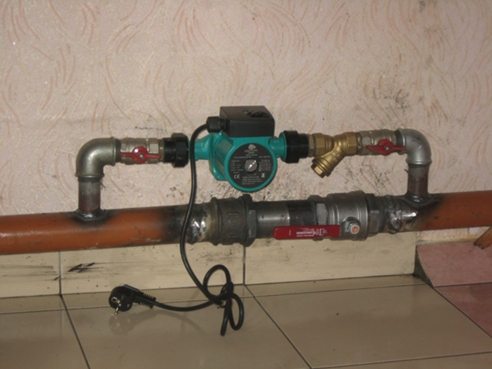

The photo shows a pump in the heating circuit.
With pressure, everything is not simple, but very simple: the contour of any length reasonable for a private house will require a pressure of no more than the minimum 2 meters for budget devices.
Reference: a drop of 2 meters makes the heating system of a 40-apartment building circulate.
The simplest way to select the capacity is to multiply the volume of the coolant in the system by 3: the circuit must be turned around three times per hour. So, in a system with a volume of 540 liters, a pump with a capacity of 1.5 m3 / h (with rounding) is sufficient.
A more accurate calculation is performed using the formula G = Q / (1.163 * Dt), in which:
- G - productivity in cubic meters per hour.
- Q is the power of the boiler or the section of the circuit where circulation is to be ensured, in kilowatts.
- 1.163 is a coefficient tied to the average heat capacity of water.
- Dt is the delta of temperatures between the supply and return of the circuit.
Hint: for an autonomous system, the standard parameters are 70/50 C.
With the notorious boiler thermal power of 36 kW and a temperature delta of 20 C, the pump performance should be 36 / (1.163 * 20) = 1.55 m3 / h.


Sometimes the capacity is indicated in liters per minute. It's easy to recount.
Calculation of the volume of the coolant in pipes and boiler
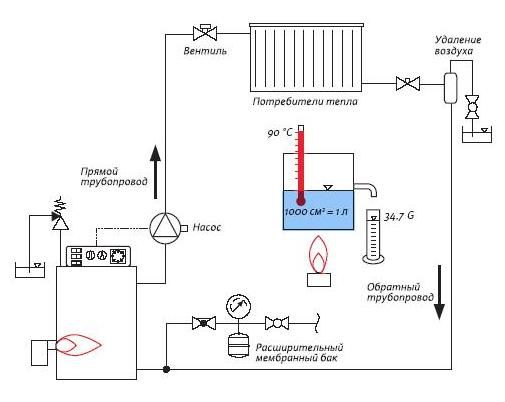

Heating system components
The starting point for calculating the technical characteristics of the components is the calculation of the volume of water in the heating system. In fact, it is the sum of the capacity of all elements, from the boiler heat exchanger to the batteries.
How to calculate the volume of the heating system yourself, without the involvement of specialists or the use of special programs? To do this, you need a layout of the components and their overall characteristics. The total capacity of the system will be determined by these parameters.
The volume of water in the pipeline
A significant part of the water is located in pipelines. They occupy a large part in the heat supply scheme. How to calculate the volume of the coolant in the heating system, and what characteristics of the pipes do you need to know for this? The most important of these is the diameter of the line. It is he who will determine the capacity of the water in the pipes. To calculate it is enough to take data from the table.
| Pipe diameter, mm | Capacity l / r.m. |
| 20 | 0,137 |
| 25 | 0,216 |
| 32 | 0,353 |
| 40 | 0,555 |
| 50 | 0,865 |
Pipes of various diameters can be used in the heating system. This is especially true for collector circuits. Therefore, the volume of water in the heating system is calculated using the following formula:
Vtot = Vtr1 * Ltr1 + Vtr2 * Ltr2 + Vtr2 * Ltr2 ...
Where Vtot - total water capacity in pipelines, l, Vtr - the volume of the coolant in 1 lm. pipes of a certain diameter, Ltr - the total length of the line with a given section.
Together, these data will allow you to calculate most of the volume of the heating system.But besides pipes, there are other components of heat supply.
For plastic pipes, the diameter is calculated according to the dimensions of the outer walls, and for metal pipes - according to the inner ones. This can be significant for long-distance thermal systems.
Calculation of the volume of the heating boiler


Heating boiler heat exchanger
The correct volume of the heating boiler can only be found from the data of the technical passport. Each model of this heater has its own unique characteristics, which are often not repeated.
The floor standing boiler can be large. This is especially true for solid fuel models. In fact, the coolant does not occupy the entire volume of the heating boiler, but only a small part of it. All liquid is located in a heat exchanger - a structure required to transfer thermal energy from the fuel combustion zone to water.
If the instruction from the heating equipment has been lost, the approximate capacity of the heat exchanger can be taken for miscalculations. It depends on the power and boiler model:
- Floor standing models can hold from 10 to 25 liters of water. On average, a 24 kW solid fuel boiler contains about 20 liters in a heat exchanger. coolant;
- Wall-mounted gas ones are less capacious - from 3 to 7 liters.
Taking into account the parameters for calculating the volume of the coolant in the heating system, the capacity of the boiler heat exchanger can be neglected. This indicator varies from 1% to 3% of the total heat supply of a private house.
Without periodic cleaning of the heating, the cross-section of the pipes and the bore diameter of the batteries are reduced. This affects the actual capacity of the heating system.
General calculations
It is necessary to determine the total heating capacity so that the power of the heating boiler is sufficient for high-quality heating of all rooms. Exceeding the permissible volume can lead to increased wear on the heater, as well as significant energy consumption.
The required amount of coolant is calculated according to the following formula: Total volume = V boiler + V radiators + V pipes + V expansion tank
Boiler
The calculation of the power of the heating unit allows you to determine the indicator of the boiler capacity. To do this, it is enough to take as a basis the ratio at which 1 kW of thermal energy is sufficient to effectively heat 10 m2 of living space. This ratio is valid in the presence of ceilings, the height of which is no more than 3 meters.
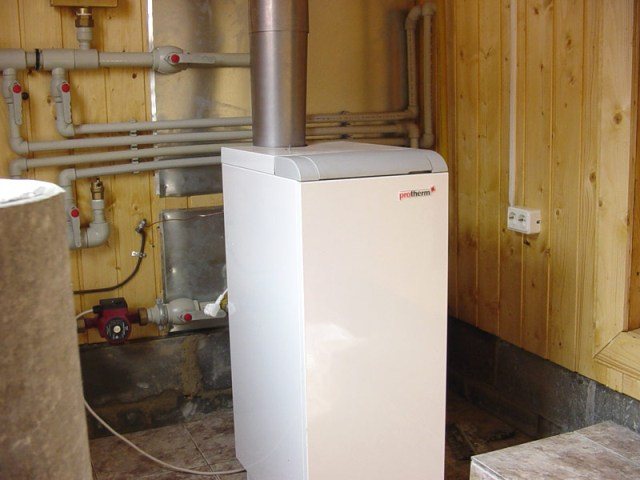

As soon as the boiler power indicator becomes known, it is enough to find a suitable unit in a specialized store. Each manufacturer indicates the amount of equipment in the passport data.
Therefore, if the correct power calculation is performed, problems with determining the required volume will not arise.
To determine the sufficient volume of water in the pipes, it is necessary to calculate the cross-section of the pipeline according to the formula - S = π × R2, where:


- S - cross section;
- π - constant constant equal to 3.14;
- R is the inner radius of the pipes.
Having calculated the value of the cross-sectional area of the pipes, it is enough to multiply it by the total length of the entire pipeline in the heating system.
Expansion tank
It is possible to determine what capacity the expansion tank should have, having data on the coefficient of thermal expansion of the coolant. For water, this figure is 0.034 when heated to 85 ° C.
When performing the calculation, it is enough to use the formula: V-tank = (V system × K) / D, where:
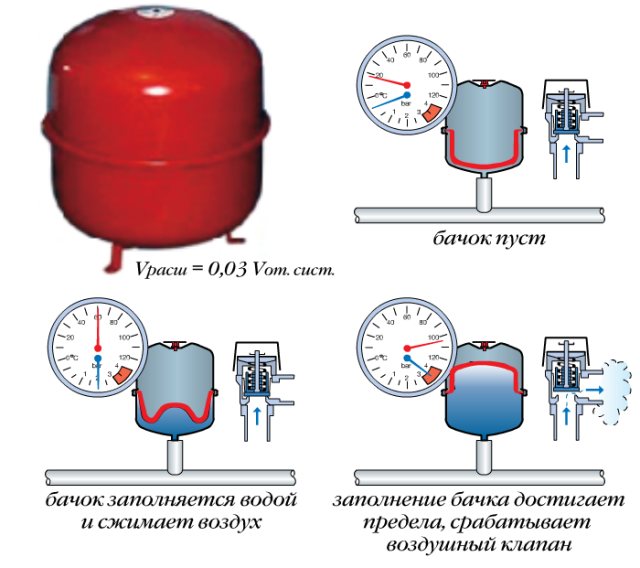

- V-tank - the required volume of the expansion tank;
- V-system - the total volume of liquid in the remaining elements of the heating system;
- K is the expansion coefficient;
- D - the efficiency of the expansion tank (indicated in the technical documentation).
Currently, there is a wide variety of individual types of radiators for heating systems. Apart from functional differences, they all have different heights.
To calculate the volume of working fluid in radiators, you must first calculate their number. Then multiply this amount by the volume of one section.


You can find out the volume of one radiator using the data from the technical data sheet of the product. In the absence of such information, you can navigate according to the averaged parameters:
- cast iron - 1.5 liters per section;
- bimetallic - 0.2-0.3 liters per section;
- aluminum - 0.4 liters per section.
The following example will help you understand how to calculate the value correctly. Let's say there are 5 radiators made of aluminum. Each heating element contains 6 sections. We make a calculation: 5 × 6 × 0.4 = 12 liters.
As you can see, the calculation of the heating capacity is reduced to calculating the total value of the four above elements.
Not everyone is able to determine the required capacity of the working fluid in the system with mathematical precision. Therefore, not wanting to perform the calculation, some users act as follows. To begin with, the system is filled by about 90%, after which the operability is checked. Then the accumulated air is released and the filling is continued.
During the operation of the heating system, a natural decline in the level of the coolant occurs as a result of convection processes. In this case, there is a loss of power and boiler performance. This implies the need for a reserve tank with a working fluid, from where it will be possible to monitor the loss of the coolant and, if necessary, replenish it.
Heating system liquid volume calculator
Pipes of various diameters can be used in the heating system, especially in collector circuits. Therefore, the volume of liquid is calculated using the following formula:
S (cross-sectional area of the pipe) * L (pipe length) = V (volume)
The volume of water in the heating system can also be calculated as the sum of its components:
V (heating system) =V(radiators) +V(pipes) +V(boiler) +V(expansion tank)
Taken together, these data allow you to calculate most of the volume of the heating system. However, in addition to pipes, there are other components in the heating system. To calculate the volume of the heating system, including all the important components of the heating supply, use our online calculator of the volume of the heating system.
Calculating with a calculator is very easy. It is necessary to enter in the table some parameters concerning the type of radiators, diameter and length of pipes, volume of water in the collector, etc. Then you need to click on the "Calculate" button and the program will give you the exact volume of your heating system.
Select the type of radiators
Total power of radiators
kw
| Pipe diameter, mm | Pipe length, m | Pipe diameter, mm | Pipe length, m |
| 16x2.0 | 20x2.0 | ||
| 26x3.0 | 32x3.0 | ||
| 20x3.4 | 25x4.2 | ||
| 32x5.4 | 40x6.7 |
The volume of water in the boiler room, collectors and fittings
l.
Heating system volume
l.
You can check the calculator using the above formulas.
An example of calculating the volume of water in the heating system:
An approximate calculation is made based on the ratio of 15 liters of water per 1 kW of boiler power. For example, the power of the boiler is 4 kW, then the volume of the system is 4 kW * 15 liters = 60 liters.
Selection of heat meters
The selection of a heat meter is carried out based on the technical conditions of the heat supply organization and the requirements of regulatory documents. As a rule, the requirements apply to:
- accounting scheme
- the composition of the metering unit
- measurement errors
- the composition and depth of the archive
- dynamic range of the flow sensor
- availability of data acquisition and transmission devices
For commercial calculations, only certified heat energy meters registered in the State Register of Measuring Instruments are allowed. In Ukraine, it is forbidden to use heat energy meters for commercial calculations, flow sensors of which have a dynamic range of less than 1:10.

